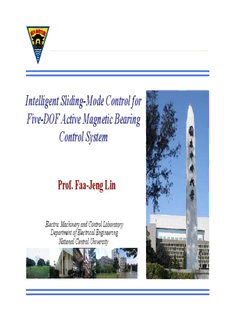
Intelligent Sliding-Mode Control for Five-DOF Active Magnetic Bearing Five DOF Active Magnetic ... PDF
Preview Intelligent Sliding-Mode Control for Five-DOF Active Magnetic Bearing Five DOF Active Magnetic ...
Intelligent Sliding-Mode Control for FFiivvee-DDOOFF AAccttiivvee MMaaggnneettiicc BBeeaarriinngg Control System Prof. Faa-Jeng Lin Electric Machinery and Control Laboratory DDeeppaarrttmmeenntt ooff EElleeccttrriiccaall EEnnggiinneeeerriinngg National Central University Electric Machinery and Control Laboratory, 1 EE, NCU, Taiwan Outline Abstract (cid:132) IInnttrroodduuccttiioonn (cid:132)(cid:132) System Dissection, Dynamic Analyses, and Experimental Designs (cid:132) of Five-DOF AMB Syystem TAMB System (cid:132) Five-DOF AMB System (cid:132) Precise Tracking Control of TAMB System (cid:132) Using Model-Free Control Methods (cid:132) UUssiinngg AAddaappttiivvee CCoommpplleemmeennttaarryy SSlliiddiinngg-MMooddee CCoonnttrrooll (cid:132)(cid:132) Using Robust Non-Singular Terminal Sliding-Mode Control (cid:132) Robust Control of Fully Suspended Five-DOF AMB System (cid:132) Using Decentralized PID Neural Network Control (cid:132) Using Decentralized Intelligent Double Integral Sliding-Mode Control (cid:132) DDiiscussiions andd CConcllusiions (cid:132) Electric Machinery and Control Laboratory, 2 EE, NCU, Taiwan Abstract In this dissertation, a fully suspended five degree-of-freedom (DOF) (cid:132) AMB control syystem,, which is compposed of two radial AMBs (RAMBs) and one thrust AMB (TAMB), is developed to fulfill the requirements of the practical applications. The motivations of this dissertation are: (cid:132) Chapters 3-5 TAMB Control System TTAAMMBB PPoossiittiioonniinngg aanndd DDeevveellooppmmeenntt ooff TTrraacckkiinngg System Tacking Controllers Reference Trajectories and Performance 22××RRAAMMBB MMeeaassuurreess PPllaannnniinngg Systems Chapters 6-7 Five-DOF AMB Control System Five-DOF AMB Regulating and Development of Decentralized System Stabilizing Control Systems OOppeerraattiinngg CCoonnddiittiioonnss aanndd PPeerrffoorrmmaannccee Measures Planning Electric Machinery and Control Laboratory, 3 EE, NCU, Taiwan Outline Abstract (cid:132) IInnttrroodduuccttiioonn (cid:132)(cid:132) System Dissection, Dynamic Analyses, and Experimental Designs (cid:132) of Five-DOF AMB Syystem TAMB System (cid:132) Five-DOF AMB System (cid:132) Precise Tracking Control of TAMB System (cid:132) Using Model-Free Control Methods (cid:132) UUssiinngg AAddaappttiivvee CCoommpplleemmeennttaarryy SSlliiddiinngg-MMooddee CCoonnttrrooll (cid:132)(cid:132) Using Robust Non-Singular Terminal Sliding-Mode Control (cid:132) Robust Control of Fully Suspended Five-DOF AMB System (cid:132) Using Decentralized PID Neural Network Control (cid:132) Using Decentralized Intelligent Double Integral Sliding-Mode Control (cid:132) DDiiscussiions andd CConcllusiions (cid:132) Electric Machinery and Control Laboratory, 4 EE, NCU, Taiwan Introduction Magnetic suspension systems have attracted increasing attentions for (cid:132) manyy apppplications such as Vibration isolation device (cid:132) High-speed maglev train (cid:132) FFaasstt-ttooooll sseerrvvoo ssyysstteemm (cid:132) Precision motion platform (cid:132) Biomedical engineering (cid:132) For several kinds of the magnetic suspension systems, magnetic (cid:132) bearing (MB) is used to suspend and move the rotor to the predefined positions functionally by the controlled electromagnetic ffoorrccee wwiitthhoouutt mmeecchhaanniiccaall ccoonnttaacctt aanndd ffrriiccttiioonn. Electric Machinery and Control Laboratory, 5 EE, NCU, Taiwan Introduction MB offers many features over conventional bearings such as (cid:132) Advantagges: Disadvantagges: Contact-free, frtionless High control complexity (cid:132) (cid:132) Elimination of the lubrication High initial cost (cid:132) (cid:132) IIddeeaall ffoorr cclleeaann-rroooomm ooppeerraattiioonn (cid:132) Minimum Equipments for fully suspended AMB Low losses and longer life (cid:132) Electromagnets 10 Higher rotational speed (cid:132) Position Sensors 5 Low vibration and noise (cid:132) Control Core (with 5AD and 5 DAconverters) 1 Tolerable against heat, cold, (cid:132) PowerAmplifiers 5 vvaaccuuuumm CCoonnssttaanntt CCuurrrreenntt SSoouurrcceess 55 MB can be divided into the passive MB (PMB), i.e. permanent MB, (cid:132) and the active MB (AMB), i.e., electromagnetic MB, mainly. The term “passive” of PMB covers MBs that do not require any external current (cid:132) feed to the bearing. TThhee tteerrmm “aaccttiivvee” ooff AAMMBB iimmpplliieess tthhaatt bbeeaarriinngg ffoorrcceess aarree aaccttiivveellyy ccoonnttrroolllleedd bbyy (cid:132)(cid:132) means of electromagnets through a well-designed closed control loop. Electric Machinery and Control Laboratory, 6 EE, NCU, Taiwan Introduction What is AMB? The elements of AMB: (cid:132) Electromagnet Power Amplifier Electromaggnet (cid:132) Rotor (cid:132) Sensor (cid:132) CCoonnttrroolllleerr (cid:132) Controller Power Amplifier (cid:132) Rotor Sensor According to its structure and usage of AMB: (cid:132) Radial AMB (RAMB) Thrust AMB (TAMB) Combination (cid:132) (cid:132) (cid:132) DDiisskk , i.e. Axial AMB RAMB TAMB Electric Machinery and Control Laboratory, Source: Schweitzer, Waukesha 7 EE, NCU, Taiwan Introduction Various applications of AMBs: (cid:132) Ω Shaft Imbalance Load Torque θ AMB1 AMB2 AMB3 Aerodynamic Loads Flywheels Helicopter and Tiltrotor 2 Stage Direct Inverter Drive Centrifugal Impellers MMaaggnneettiicc BBeeaarriinngg SSttaaggee TTurbbomollecullar Inlet Pumps Guide Vanes Compressor Motor and Bearing Controls Bearingless Heart PMB Hard Drive Motor Pump Higgh-Sppeed Sppindle Electric Machinery and Control Laboratory, Vacuum VesselBlood Pump Maglev Trains 8 EE, NCU, Taiwan Introduction In the AMB system: (cid:132) A fixed current is supppplied to each electromaggnet and can be referred as the (cid:132) bias current i . (i =>x ) b b 0 A variable current is superimposed on the bias current, which is obtained by the (cid:132) desiggned controller and can be referred as the control current i . ((ii =>△△xx)) cc c The purpose of the bias setting is to improve the linearity of the (cid:132) force-current relationships around the operating point (i , x ). b 0 The operating modes of the drive system which supply the currents (cid:132) to the electromagnets can be classified into three classes: CCllass-AA ddriiviing modde ((ddiifffferentiiall ddriiviing modde, DDDDMM)); (cid:132) Class-B driving mode; (cid:132) i - i i - i - i Class-C driving mode. b c b c c (cid:132) i + i i i b c b c Class-A Class-B Class-C Electric Machinery and Control Laboratory, 9 EE, NCU, Taiwan Introduction Comparisons of various developed AMB systems: (cid:132) Electric Machinery and Control Laboratory, 10 EE, NCU, Taiwan
Description: